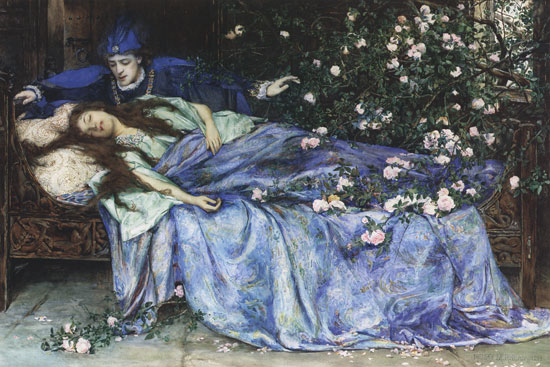
The famous non-consensual kiss from “Sleeping Beauty.” Image by Henry Meynell Rheam (in public domain).
I spent a good chunk of this year’s annual meeting of the American Folklore Society live-tweeting the conference. And, given that I’m now working as a sex educator, a lot of what I tweeted about was sexuality and gender.
When I tweeted disparagingly about the lack of sex positivity at the conference, a colleague responded by asking what exactly I mean by sex positivity. It’s not, unfortunately, something that everyone in our society learns about, nor is it on the curriculum for most folklore studies programs. So I wrote this blog post about what sex positivity means to me, and decided to do a follow-up post relating it back to folklore.
In folklore studies, and especially my specialty of narrative studies, we spend a lot of time talking about genres. A genre is a basic category of folklore, a type of expressive culture that we group by similarities in content, structure, transmission/performance, and function. So my first thought when it comes to relating sex positivity to folklore is to write about which genres engage with sex positivity (or not).
Based on the paper I gave this year, examining gender and sexuality in the TV show Lost Girl, I’ve been thinking about sex positivity in two specific narrative folklore genres: legend and fairy tale. We define legends as belief tales that are told as though they actually happened, which is why you so see so many urban legends debunked on Snopes.com: they tie into people’s beliefs about reality, so strongly that they’ll be transmitted regardless of their truth value.
For a representative sampling of legends about sex, check out these summaries of texts from just one legend book, The Vanishing Hitchhiker by folklorist Jan Brunvand: innocent make-out sessions lead to death in “The Boyfriend’s Death,” infidelity is punished in “The Solid Cement Cadillac,” and various nude surprises occur because people are generally acting pervy. Then there are legends regarding the transmission of HIV/AIDS, organ theft after a one-night stand, people getting stuck together during sex, and people losing objects internally during masturbation.
Based on this sample, I think it’s safe to say that most legends are NOT sex positive. They depict sex acts as having dangerous consequences. Even if a character’s intention was not malevolent, the effects are harmful. This probably relates to how legends function in society: they often contain socially conservative messages meant to police communal behavior.
With fairy tales—which have a bit more distance from reality as they’re fictional, formulaic tales about magic, quests, and transformation—it’s a bit harder to make sweeping proclamations about whether or not they’re sex positive. Most fairy tales end in marriage, after all, which would seem to be an endorsement for sex. However, fairy tales give us a fairly narrow vision of acceptable forms of sexuality: most fairy-tale pairings are heterosexual, monogamous, and transactional.
I’ve been researching promiscuity and non-monogamy in fairy tales, and based on that, I’ve concluded that fairy tales (like legends) convey rather restrictive attitudes about sexuality. Promiscuous female characters are punished, while there’s rarely any comment on the need for a man to be a virgin before marriage (yes, there are tales about magical virginity tests before marriage—only for the female characters, of course). It’s a little disturbing to realize that fairy tales contain many similar elements to contemporary abstinence-only programming: an emphasis on virginity before marriage, a need to police sexual behavior especially in women, and a correlation between chastity and virtue. (want citations? contact me for a copy of my paper)
In contrast to legends, though, fairy tales do show sexuality as being potentially generative and therefore positive in that light at least. Sex in fairy tales leads to children, and fairy-tale children are generally valued. You never know when having a kid might lead to breaking a curse down the road, after all. So while it’s still a mixed bag, I have to conclude based on this brief survey that fairy tales are a bit more sex positive than legends.
I can’t think of any other folklorists using sex positivity as a metric to evaluate the messages within various folklore genres. This could be an intriguing and useful line of inquiry, so if you have suggestions for folklore genres to compare and contrast in regard to sex positivity, feel free to leave a comment and get in on this discussion!
